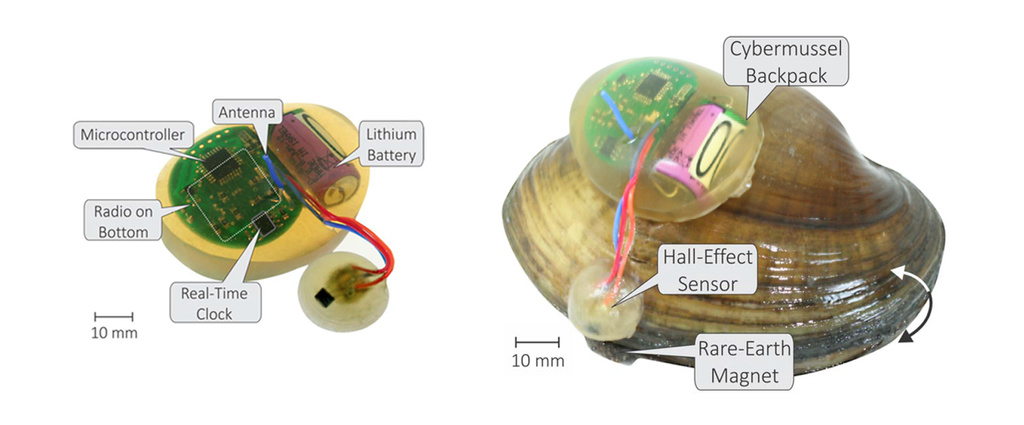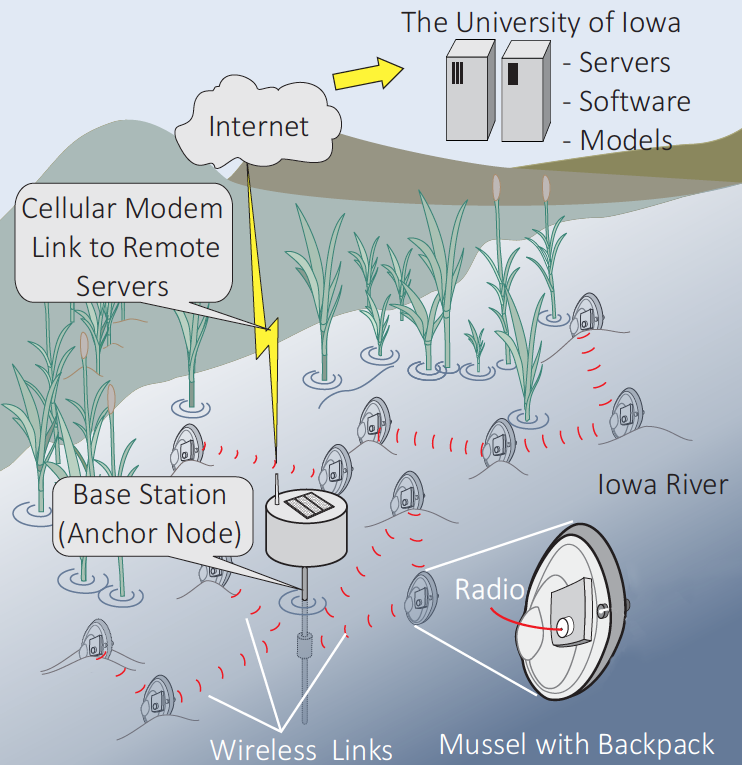University of Iowa researchers are studying how to enlist the help of large numbers of freshwater mussels, which they would outfit with electronic monitors, to learn more about the nitrogen cycle in river water. Their ultimate goal is to reduce harmful nitrates in Midwestern waterways.
Researchers are testing tiny electronic backpacks developed at the UI on a group of mussels kept in a lab in order to determine if the equipment will in any way impede the mussels’ natural movement or behavior.
If the mechanisms prove adequate, researchers will retrieve wild mussels from the Iowa River, glue the backpacks to their shells, and release the mollusks back into the wild. The battery-powered backpacks will then transmit data to servers on the UI campus.
This study will use mussels as living water-quality sensors so researchers can ultimately develop solutions for mitigating the harmful effects of nitrogen runoff, a significant problem in agricultural states.
Mussels draw in river water and pump it through their systems, filtering out nutrients. Mussels could be powerful water purifiers if revived to their historic populations, which were devastated in the early 1900s—in part by the Muscatine pearl button industry, which used freshwater mussel shells to produce pearl buttons and was at one time considered the pearl button capital of the world.

Iowa and other states unintentionally export excess nitrates from fertilizers to the Gulf of Mexico via local rivers and streams that are part of the Mississippi River watershed. Nitrates settle in the Gulf, leading to algal blooms as large as 6,000 to 7,000 square miles that deplete oxygen in the water and cause "dead zones" that are devastating to Gulf fisheries. Researchers hope cybermussels will provide data valuable for developing strategies to minimize Iowa's contribution to problems in the Gulf.
The electronic backpack being developed by UI engineers will communicate measurements of a mussel’s gape—the rhythmic opening and closing of the mussel's valve—in real time. This will give researchers immediate feedback if the mussels’ regular cycles are disrupted, indicating a change in their environment.
Mussels are environmental sentinels or “canaries in the coal mine,” often the first to be adversely affected when ecosystems are weakened by pollution or other disturbances, making them uniquely qualified for water-quality research.

The pocketbook mussels used in this study live for more than 50 years and likely would outlive the battery life of the devices, which is about one year. This single year of data, researchers say, would provide valuable insight into the lives of the mollusks and the environmental issues that affect rivers.
Mussels are, in essence, living water filters. An average adult mussel processes gallons of water a day.
When populations are healthy, mussels and the bacteria they interact with can transfer large amounts of nitrogen from waterways into the sediment of a riverbed, thus preventing nitrogen from reaching the Gulf.
“These organisms play a huge role in the nitrogen cycle, and the way they couple with how other organisms like bacteria function, it could be some of our engineering solutions for nitrogen-management issues in the future,” says Craig Just, assistant professor of civil and environmental engineering.
The UI’s project is a collaboration between Just; Anton Kruger, professor of electrical engineering; and Ruben Llamas, who recently received a Ph.D. in electrical engineering from the UI.